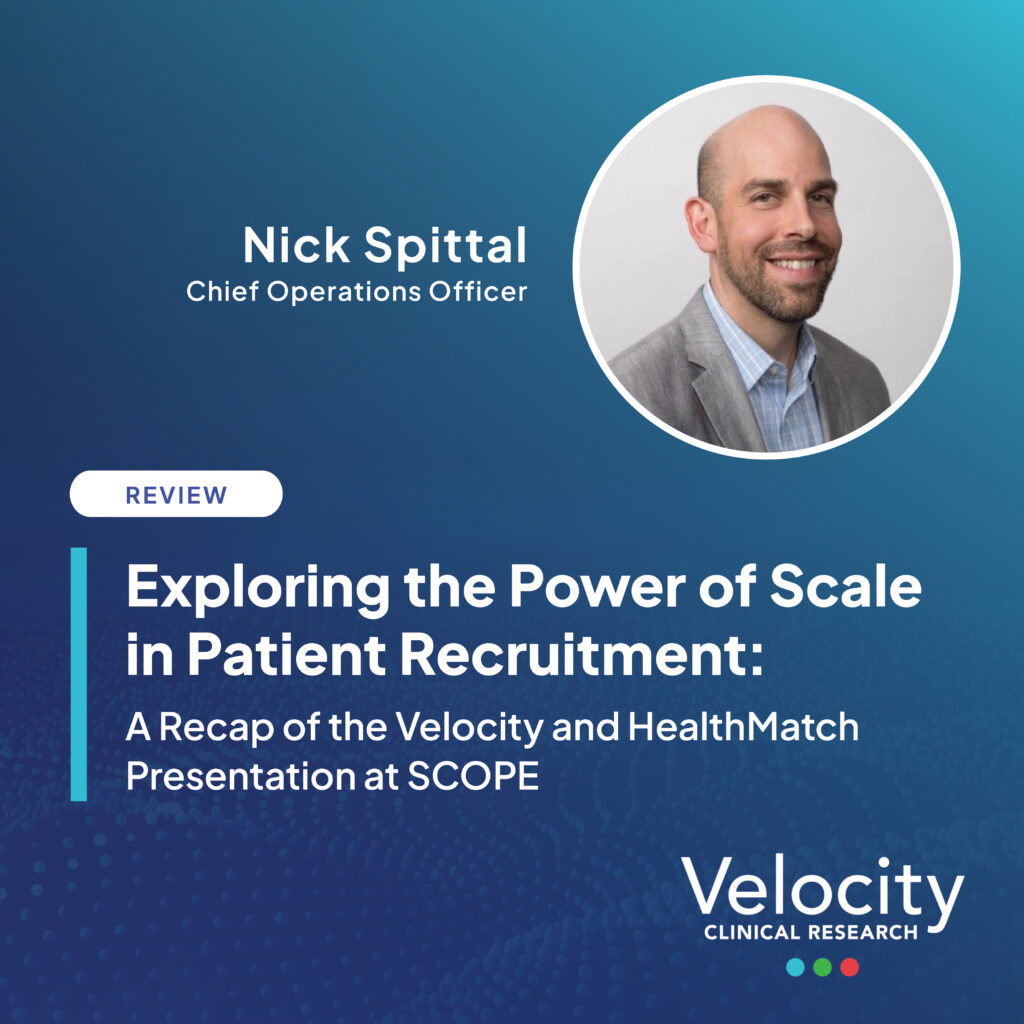Last month, Nick Spittal, Velocity’s chief operating officer announced the company’s latest partnership with HealthMatch and results from an unprecedented patient recruitment pilot at the SCOPE conference in Orland, Florida. He was joined by HealthMatch CEO, Manuri Gunawardena, on stage for a joint presentation, as Clinical Trials Report journalist Michael Causey reports:
Velocity announced its partnership with HealthMatch on an innovative patient-centric recruitment pilot during the session, “A Platform Based Approach to Patient Recruitment & Enrollment: Maximizing Patient & Sponsor Experience.”
“We share a common mission to accelerate clinical research,” Spittal told attendees, “We’re both committed to technology and data as twin investments and invaluable enablers,” he continued, outlining lessons learned, as the partnership’s first massive pilot project wraps up.
The pilot project offers a new way of approaching clinical trial patients, tapping into the HealthMatch patient pool and leveraging Velocity’s wide array of ongoing and prospective trials. Consequently, the two entities were able to maintain more regular contact with patients.
For example, Velocity is engaged in a number of trials related to the treatment of migraines. Under previous models, if a patient wasn’t right for a specific migraine study, they might miss out learning about other opportunities to participate in different trials. But working together, Velocity and HealthMatch developed a more ongoing relationship with patients that proved more nimble when connecting patients with a different trial matching their criteria, Spittal said.
Working together, Velocity is leveraging HealthMatch’s more than 1.3 million patients globally. After partnering on 174 studies across 78 sites over a four-week period across a wide array of therapeutic areas, Velocity has been able to “expand its footprint” with access to a deeper reservoir of patients potentially interested in participating in a clinical trial, Spittal said. Velocity harnessed a “relentless focus on optimal processes to operate trials at unseen speed,” he added.
For example, nearly all patients referred to by HealthMatch were contacted within twenty-four hours or less of their initial engagement — that translated into a 10% higher enrollment rate, Spittal said.
All told, the pilot project pre-screened and referred 11,188 patients, with 1,685 ultimately scheduled for enrollment in a trial. “There’s a power in scale,” when Velocity and HealthMatch are banded together, Spittal said at the conference. This breadth of study coverage is unprecedented for a partnership between a site organization and specialty recruitment firm. The scale has allowed Velocity and HealthMatch to align incentives based on enrollment outcomes. This is a preferred model for sponsors who are paying the bill to enroll patients on studies, and sites and services have been unable or unwilling to deliver on historically.
Sharing complementary strengths unified by a shared patient-first vision, Velocity Clinical Research and HealthMatch are reporting outstanding results from their first massive clinical trial project together.
“We have a like mind set, an innovative approach that puts the patient front and center,” Spittal said. Partnering with HealthMatch also helps both organizations better connect with patients on an ongoing basis and make the clinical trial experience less “transactional,” Spittal said. “We have a shared lens focused on patient centricity,” he added. That approach helps to create deeper relationships with patients, Spittal noted.
Looking ahead, Spittal said the team and its tech automation capabilities will significantly improve trial recruitment, especially after pre-screening and before scheduling, which is a common “friction point” in trial recruitment. “We will be better able to predict and prioritize top qualifiers” across multi-lingual and multi-country geographic areas, he added.

